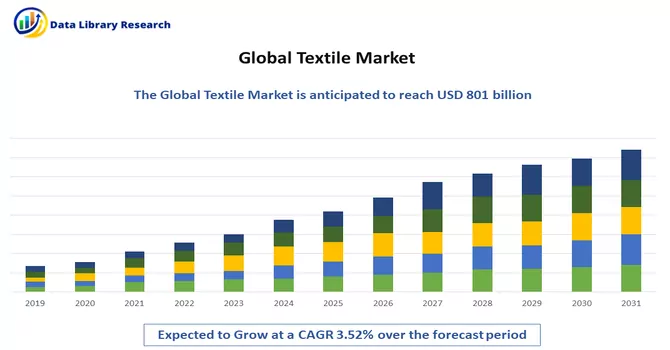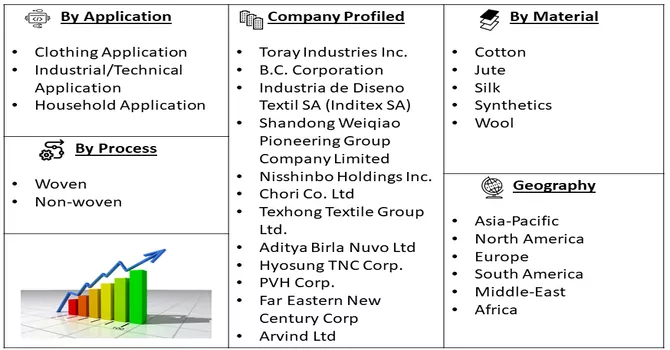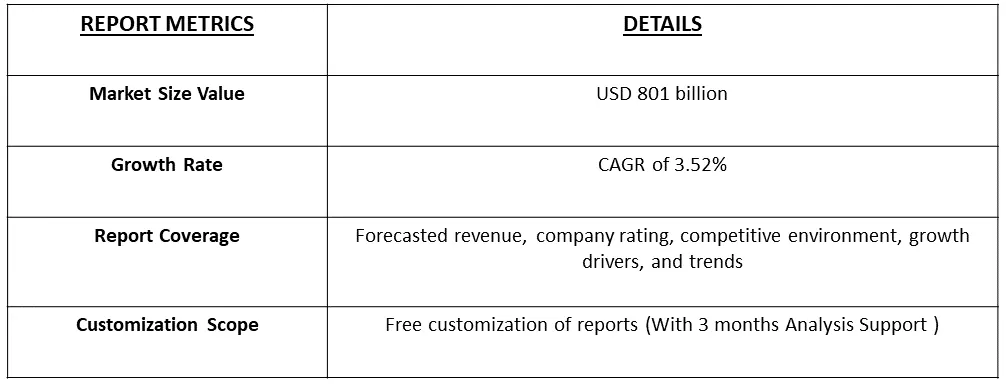The Textile Industry is currently valued at USD 801 billion in 2023 and is expected to register a CAGR of 3.52% during the forecast period, 2023-2030.

Get Complete Analysis Of The Report - Download Free Sample PDF
The textile industry refers to a diverse sector involved in the production of fibers, fabrics, and finished textile products. It encompasses a range of processes, from the initial stages of fiber production to the final manufacturing of various textile goods. Key components of the textile industry include the cultivation or extraction of raw materials (such as cotton, wool, or synthetic fibers), spinning, weaving or knitting, dyeing, and finishing. The industry produces a wide array of textile products, including clothing, home textiles, industrial textiles, and technical textiles, contributing significantly to the global economy and serving as a crucial part of the manufacturing and consumer goods sector.
The demand for textiles is largely driven by consumer preferences for clothing, home furnishings, and other textile-based products. Trends, fashion preferences, and changing lifestyles influence the demand for different types of textiles. The economic prosperity of a region or country positively impacts the textile industry. As disposable incomes rise, consumer spending on clothing and textiles tends to increase, driving demand for textile products. Moreover, the growing awareness of environmental issues has led to increased demand for sustainable and eco-friendly textiles. The adoption of environmentally responsible practices, such as using organic fibers and reducing water and energy consumption, contributes to the industry's growth.
The growing emphasis on sustainability throughout the textile supply chain, increased use of eco-friendly materials such as organic cotton, recycled fibers, and biodegradable synthetics and adoption of sustainable dyeing and finishing processes to minimize environmental impact. Also, increasing focus on diversity and inclusion in marketing, design, and representation within the textile industry and embracing diverse cultural influences and promoting inclusivity in product offerings are the market trends that are contributing to this market growth. These trends collectively shape the evolving landscape of the textile industry, influencing business strategies, product development, and consumer interactions.
Market Segmentation : The Global Textile Market is Segmented by Application Type (Clothing Application, Industrial/Technical Application, and Household Application), By Material (Cotton, Jute, Silk, Synthetics, and Wool), By Process (Woven and Non-woven), and By Geography (North America, Europe, Asia-Pacific, Latin America, and the Middle East and Africa). The report offers market size and forecasts for the textile industry in Value (USD billion) for all the above segments.

For Detailed Market Segmentation - Download Free Sample PDF
Market Drivers :
The Ever-Changing Demand from Consumers for a Wide Range of Textile Products, Including Clothing, Home Textiles, and Technical Textiles
The textile industry is perpetually influenced by the ever-changing demand from consumers, encompassing a diverse array of textile products that span clothing, home textiles, and technical textiles. This dynamic demand is a driving force that shapes the industry's trends, production strategies, and innovations. Consumers' desire for on-trend, affordable clothing has fueled the fast fashion phenomenon. The industry responds with rapid production cycles, shorter lead times, and agile manufacturing processes to meet these demands. The rise of e-commerce platforms and direct-to-consumer models has transformed the retail landscape, providing consumers with greater accessibility to a wide range of textile products and enabling more direct interactions with brands. Thus, the textile industry's ability to navigate and thrive lies in its responsiveness to the ever-evolving demands of consumers. Whether driven by fashion trends, sustainability concerns, or the need for innovative solutions, consumer demand remains a pivotal force shaping the trajectory of the textile industry.
Textile Market Consumer Preferences for Customized and Personalized Products
Consumer preferences for customized and personalized products have significantly influenced the textile industry, transforming the way textiles are designed, manufactured, and marketed. This growing trend reflects a shift in consumer expectations, seeking products that align with their individual tastes, preferences, and lifestyle. Moreover, the consumers increasingly seek clothing items that are tailored to their specific measurements and style preferences. Customization in sizing, fit, and design allows individuals to have unique and well-fitted garments. Moreover, brands and manufacturers offer options for consumers to personalize the designs of their clothing items. This may include choosing colors, patterns, embroidery, or even incorporating personalized labels.
Market Restraints :
Limited Research and Development Investment and Economic Volatility
Some companies may face restraints in allocating sufficient resources for research and development, limiting their ability to innovate and stay competitive. Moreover, economic downturns can lead to reduced consumer spending on non-essential goods, affecting the demand for textiles. The industry is vulnerable to economic fluctuations. Thus, such factors are expected to slow down the growth of the studied market over the forecast period.
The COVID-19 pandemic has had a profound impact on the global textile industry, disrupting supply chains, altering consumer behavior, and presenting unprecedented challenges. The closure of manufacturing hubs in major textile-producing countries, including China and India, disrupted the supply chain. Lockdowns and restrictions led to factory closures, affecting the production of raw materials and finished goods. In the current scenario, the recovery of the textile industry has been uneven across regions and segments, with factors such as vaccination rates, economic conditions, and government policies influencing the pace of recovery. The long-term impacts of the COVID-19 pandemic on the textile industry will likely continue to shape the sector, influencing trends, sustainability practices, and the overall resilience of businesses in the post-pandemic era. Thus, such factors are expected to slow down the studied market growth over the studied period.
Segmental Analysis :
Clothing Application Segment is Expected to Witness Significant Growth Over the Forecast Period
The clothing application is one of the primary and most pervasive sectors within the broader textile industry. Textiles play a crucial role in the creation of clothing, serving as the raw materials from which garments are crafted. The textile industry provides a vast array of fabrics, each with unique properties, textures, and appearances. Fabrics range from natural fibers like cotton and wool to synthetic materials such as polyester and nylon. The textile industry is deeply intertwined with the fashion world. Textile manufacturers closely collaborate with fashion designers and brands to create fabrics that align with current trends and styles. The textile industry caters to the growing demand for specialized clothing, such as sportswear and activewear. High-performance fabrics are designed to enhance comfort, flexibility, and moisture management during physical activities. Thus, owing to such advantages, the segment is expected to witness significant growth over the studied period.
Cotton Material Segment is Expected to Witness Significant Growth Over the Forecast Period
Cotton is a natural fiber obtained from the cotton plant's seed fibers. It is known for its versatility, softness, and comfort, making it a popular choice for a wide range of textile applications. Cotton is extensively used in the production of apparel, including shirts, T-shirts, jeans, dresses, and undergarments. Its softness against the skin and absorbent nature contribute to its popularity in clothing. Cotton is known for its skin-friendly properties, making it suitable for people with sensitive skin. It reduces the risk of irritation and allergies commonly associated with synthetic fibers. Thus, owing to such advantages, the segment is expected to witness significant growth over the studied period.
Woven Segment is Expected to Witness Significant Growth Over the Forecast Period
The woven process involves two sets of yarns – warp and weft. The warp yarns run lengthwise, parallel to the fabric's selvedge, while the weft yarns run across the width, perpendicular to the warp. The actual weaving occurs on a loom, where the warp yarns are lifted and lowered by harnesses, creating an opening (shed) for the weft yarn to be inserted. The weft yarn is passed through the shed using a shuttle, and the process is repeated to form the fabric. Moreover, the advancements in digital technology have led to the development of computerized looms capable of intricate and customizable designs. Thus, owing to such advantages, the segment is expected to witness significant growth over the studied period.
North America is Expected to Witness Significant Growth Over the Forecast Period
North America has a rich history in textile manufacturing, dating back to the early days of the industrial revolution. The region played a crucial role in the development of textile mills and the mechanization of weaving and spinning processes. The region is also involved in the production of technical textiles used in various industries, including automotive, aerospace, and healthcare.
North American textile companies increasingly prioritize sustainability. Efforts include using eco-friendly materials, adopting responsible production practices, and reducing environmental impact. Also, the region is home to high-end fashion brands that often source and produce textiles locally or globally based on design requirements.
Anticipated to experience rapid expansion in the foreseeable future, North America is poised for substantial growth, fueled by the increasing activities in industrial manufacturing and a surge in product launches within the sports and fashion sectors. The United States is anticipated to maintain its pivotal role as a major contributor to cotton production, driven by escalating demand for textile products across diverse end-use industries. The textile market is witnessing notable product demand, particularly in industrial manufacturing and the home textile sector, owing to heightened awareness regarding the versatile applications of technical textiles. Thuus, such factors are expected to contribute the significant growth of this market in the region.

Get Complete Analysis Of The Report - Download Free Sample PDF
The report encompasses the key players within the textile industry. In the context of market share, companies in the global textile industry do not command a significant portion of the market, given its highly competitive and fragmented nature. The industry features numerous players vying for market presence, and no single entity holds a substantial share. The competitive landscape is characterized by a multitude of players, each contributing to the overall dynamism and competitiveness of the textile market on a global scale.
Some market players working in this domain are:
Recent Development
1) In Feb 2021, The Indian Government has announced the setting up of seven mega textile parks in the next three years. The government has also decided to rationalize the duties on raw material inputs to manmade textiles by reducing the customs duty rate on caprolactam, nylon chips, and nylon fiber and yarn to 5 %.
2) In Feb 2021, Paraguay's Ministry of Industry and Commerce announced that it will be investing USD 1.1 million in the manufacturing sector, mainly benefiting the clothing, textiles, and footwear industries, among other areas related to assembly operations.
Q1. What is the current Textile Market size?
As per Data Library Research the Textile Industry is currently valued at USD 801 billion in 2023.
Q2. At what CAGR is the market projected to grow within the forecast period ?
Textile Market is expected to register a CAGR of 3.52% during the forecast period.
Q3. What are the factors on which the Textile Market research is based on?
By Application, By Material, By Process, End-User and Geography are the factors on which the Textile Market research is based.
Q4. Which Region is expected to hold the highest Market share?
North America region is expected to hold the highest Market share.
Data Library Research are conducted by industry experts who offer insight on industry structure, market segmentations technology assessment and competitive landscape (CL), and penetration, as well as on emerging trends. Their analysis is based on primary interviews (~ 80%) and secondary research (~ 20%) as well as years of professional expertise in their respective industries. Adding to this, by analysing historical trends and current market positions, our analysts predict where the market will be headed for the next five years. Furthermore, the varying trends of segment & categories geographically presented are also studied and the estimated based on the primary & secondary research.
In this particular report from the supply side Data Library Research has conducted primary surveys (interviews) with the key level executives (VP, CEO’s, Marketing Director, Business Development Manager and SOFT) of the companies that active & prominent as well as the midsized organization
FIGURE 1: DLR RESEARH PROCESS

Extensive primary research was conducted to gain a deeper insight of the market and industry performance. The analysis is based on both primary and secondary research as well as years of professional expertise in the respective industries.
In addition to analysing current and historical trends, our analysts predict where the market is headed over the next five years.
It varies by segment for these categories geographically presented in the list of market tables. Speaking about this particular report we have conducted primary surveys (interviews) with the key level executives (VP, CEO’s, Marketing Director, Business Development Manager and many more) of the major players active in the market.
Secondary ResearchSecondary research was mainly used to collect and identify information useful for the extensive, technical, market-oriented, and Friend’s study of the Global Extra Neutral Alcohol. It was also used to obtain key information about major players, market classification and segmentation according to the industry trends, geographical markets, and developments related to the market and technology perspectives. For this study, analysts have gathered information from various credible sources, such as annual reports, sec filings, journals, white papers, SOFT presentations, and company web sites.
Market Size EstimationBoth, top-down and bottom-up approaches were used to estimate and validate the size of the Global market and to estimate the size of various other dependent submarkets in the overall Extra Neutral Alcohol. The key players in the market were identified through secondary research and their market contributions in the respective geographies were determined through primary and secondary research.
Forecast Model
